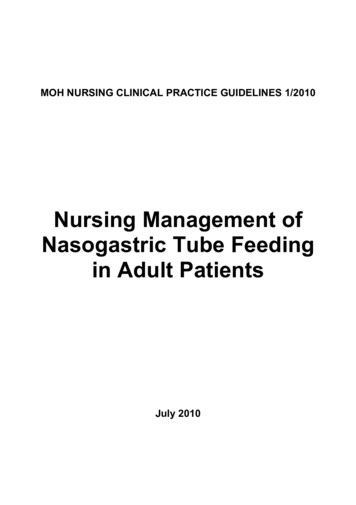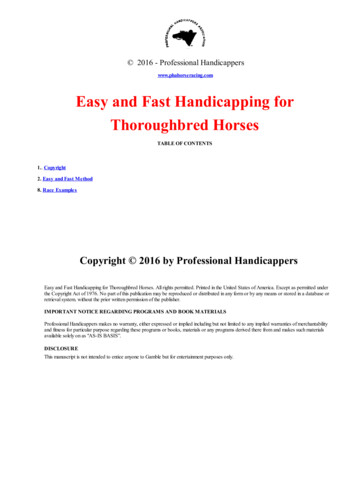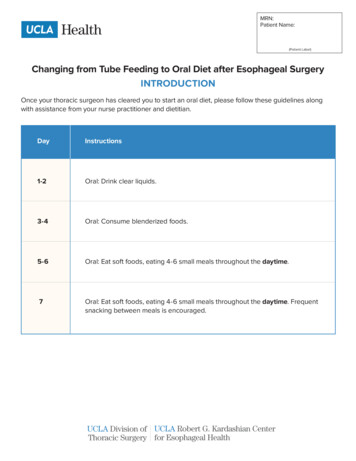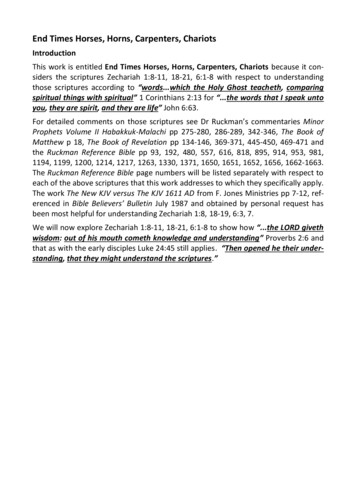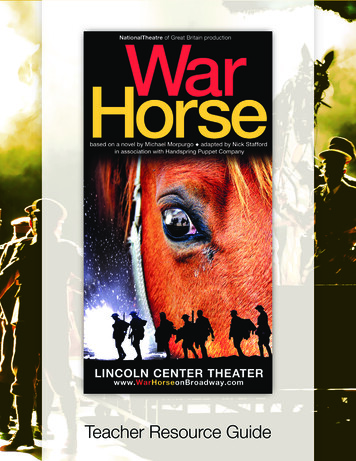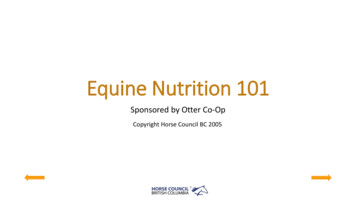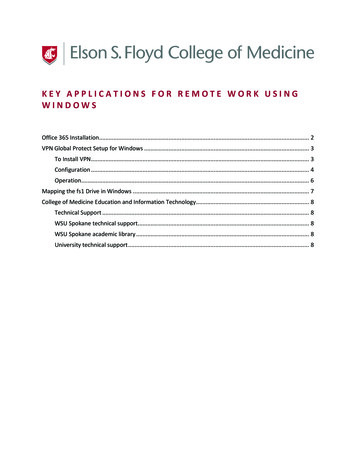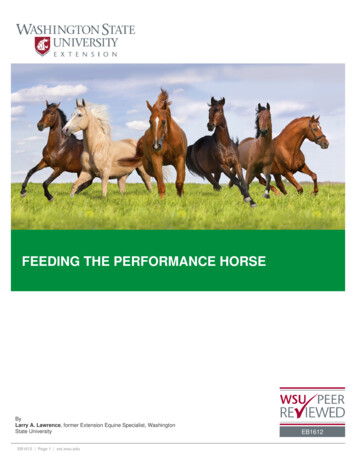
Transcription
FEEDING THE PERFORMANCE HORSEByLarry A. Lawrence, former Extension Equine Specialist, WashingtonState UniversityEB1612 Page 1 ext.wsu.eduEB1612
WSU EXTENSION FEEDING THE PERFORMANCE HORSEFeeding the Performance HorseThe horse has an enormous capacity for physical work. Itsathletic potential for speed, endurance, and agility renewed itspopularity in sports events such as endurance riding, three-dayevents, and cutting competitions. A horse’s inherent athleticability is highly dependent on genetics. Certain breeds andlines of horses are better suited for specific events. Horsesshould be selected for particular activities based on geneticpotential, then trained and conditioned for that specific activity.evaluate a horse’s condition and nutritional status is by body weightand/or condition scores. Livestock scales are needed for accuratedetermination of weight, and accurate weights are very helpful inpredicting performance. If scales are not available then equineweight tapes can be used to estimate body weight. However, theyare not accurate enough to monitor changes that may affectperformance. For example, a difference of 1% in the horse’s weight(11 lbs. in a 1,100-lb. horse) can affect performance of race horses.Table 1 contains conversions from inches measured around theheart girth to estimated weight. A condition score system (Figure 1)has been developed at Texas A&M based upon visual appraisal andpalpable fat cover. Horses are rated from emaciated to extremelyfat. Horses should be fed based upon a percentage of their bodyweight (Table 2). Once the horse’s weight has been estimated youcan calculate the amount of feed it will require. Don’t measure feedby volume; weigh it on a scale (Table 3).Conditioning ProgramIt is difficult to separate condition and fitness from nutrition inperformance horses. The horse that has been laid off for the wintermay come into the season underweight or overweight. So, part ofthe program may include weight gain or reduction.As we continuously challenge the horse’s performanceabilities, we seek the finished horse, an animal that has peakedin its training and conditioning program. The trainer isresponsible for the level of fitness a horse has for a specificactivity. Two very important systems help determine thesuccess of a performance horse:1) Nutrition/energy metabolism—the supply of energy and itsutilization.2) Conditioning/fitness—the mechanics of gait, coordination,and muscular strength.Nutrition and conditioning development programs are closelyrelated to and dependent on each other. One of the best ways toEB1612 Page 2 ext.wsu.eduA good fitness conditioning program combined with propernutrition influences energy use. The performance horse uses80–90% of its feed for energy metabolism. The muscles canactually be trained to use energy substrates (carbohydrates and fats)more efficiently. There are two general muscle fiber groups: fasttwitch and slow twitch muscle fibers. Glycogen (carbohydrate) isthe stored form of energy that hard-working fast twitch musclefibers use most. Research has shown that glycogen can be increasedby 33% during a conditioning program of10 weeks. Slow twitchfibers are associated with endurance-type activities. Enduranceconditioning can increase the aerobic capacity, or ability to deliverand utilize oxygen and energy-rich fatty acids. Both groups ofmuscle fibers respond to endurance training by increasing theaerobic capacity. This is one key to a good conditioning program.There are many ways to condition horses. The best conditioningprograms increase aerobic capacity and prepare them for the actualwork they will perform (Table 4). One conditioning system isknown as interval training. Interval training builds horses upgradually to the actual work that will be expected of them. Intervaltraining stresses the horse’s cardiovascular and locomotor systemsduring repeated short exercise bouts interrupted by rest or recoveryperiods. This work-rest system builds resistance to the stress ofexercise and slowly conditions horses to their maximum potential.
WSU EXTENSION FEEDING THE PERFORMANCE HORSEMonitoring heart rates is a good way to determine theeffectiveness of the conditioning program. At heart rates above150–180 beats/minute, muscular energy supplies, and thecardiovascular system cannot keep up with the demands. One ofthe results of this type of work is that fuel is burned withoutoxygen, or anaerobically. At heart rates below 100–150beats/minute mostly aerobic work is being performed. Aerobicwork is slow, distance work that the horse can do for long periodsof time before fatigue. This simplified explanation provides anidea of how hard a horse is working during various activities.Fatigue and Energy MetabolismThe association between fitness and nutrition can also be seen infatigue. Equine exercise physiologist D.F. McMiken reports thereare three types of fatigue: (1) structural fatigue—weakened anddamaged bone, tendons, or muscle fiber damage, resulting in tyingup (muscle spasms) and soreness; (2) chronic fatigue—starvation,muscle glycogen depletion; and (3) acute fatigue—end-of-race,glycogen depletion, reduced energy substrates, increased lacticacid and lowered pH in the muscle and blood.All performance events require the use of anaerobic and aerobicenergy metabolism. Anaerobic exercise, or speed work, ispartially limited by the horse’s ability to metabolize or burn fuelsefficiently. Stored muscle glycogen is the predominant source offuel for high-intensity speed work. At high speeds muscleglycogen metabolism occurs at a rate that limits the use of oxygenin the fuel-burning process. All fuels burn more efficiently in thepresence of oxygen. Anaerobic glycolysis, or the burning ofglycogen without oxygen, is inefficient and results in theproduction of lacticEB1612 Page 3 ext.wsu.edu
WSU EXTENSION FEEDING THE PERFORMANCE HORSEacid. Although researchers no longer believe that lactic acid isthe main cause of fatigue, they still believe it is one factorleading to fatigue. The conditions that create lactic acidbuildup also cause pH to decrease in muscles, which creates amore acidic environment and leads to fatigue.Aerobic exercise is more efficient than anaerobic exercisebecause the horse can deliver adequate oxygen to burn fuels.Energy for aerobic exercise is derived from glycogen andstored body fat and/or free fatty acids. These fuels are burnedefficiently in the presence of oxygen with little buildup oflactic acid. While aerobic exercise is more efficient, it canresult in glycogen depletion and fatigue if the work isprolonged.NutritionAfter you have evaluated your horse’s condition and weightand planned a fitness conditioning program, develop anutritional program for each horse. The program must bedesigned primarily to supply energy to mature horses. Theprogram can be monitored by feeding the horses to maintain aparticular body weight and level of fatness.EnergyThe energy requirements for individual horses doing the sameamount of work can vary as much as 30%. Energy can beobtained from structural plant carbohydrates found in forages(cellulose), simple carbohydrates found in grain (starch),protein, and fat. The energy requirements can be measured asdigestible energy (DE) in megacalories (Mcal).A mature horse at maintenance (normal daily activities,grazing, etc.) or performing one hour of light work per day(walking, slow trotting, some n cantering, or a pleasure ride)can perform well on a diet of alfalfa or immature timothy hay,if supplemented with trace minerals and a clean, fresh watersupply. The nutrient content of forage is determined by itsstage of growth or maturity. More mature forage contains lessEB1612 Page 4 ext.wsu.eduavailable energy, protein, and other nutrients. Immature forageis more nutritious. Tables 5 and 6 illustrate the effects ofmaturity of timothy and alfalfa hay on the forage’s nutrientcontent, and how it relates to the requirements of a horse doingone hour of light work.Sometimes you may want to limit hay intake (never limit haybelow 1% of body weight, 11 lbs. hay for 1,100-lb. horse) andsupplement with grain (Table 7). Many “hard keepers” cannotmaintain proper condition without grain. Also, some horses fedlarge amounts of mature hay develop “hay belly.” Thefeedstuffs used in Table 7 are a typical timothy hay andcommercial diet designed to be fed with grass hay. Grain canbe a commercial grain mix, either a textured feed with wholeor rolled grains or a ground pelleted feed. Grains such as oats,corn, and/or barley can be used singly or in combination. Ifyou feed grain alone, add two ounces (60 grams) of a tracemineral supplement per day.The energy required for work depends on the amount of timespent working and the intensity of the work. Nutritionalprograms are divided into two categories, those for long, lowintensity, activities and those for short, high-intensityactivities. Horses in the first category are endurance andcompetitive trail horses, draft or ranch work horses, and otherhorses ridden or driven moderately several hours per day.When the intensity of work or the time spent working isincreased, increase the dietary energy.High-intensity activities where the horse performs at 80–100%of its maximum ability for a short duration include racing,polo, three-day eventing or cross-country. In these types ofactivities much of the energy must come from storedcarbohydrates or glycogen derived from the grain portion of
WSU EXTENSION FEEDING THE PERFORMANCE HORSEthe ration (Table 8). The high levels of grain fed in thisexample should only be fed to intensely worked horses. Veryfew recreational horses are in this category.Light work for two or three hours per day may increase energyrequirements 50% above maintenance. If a horse performs amoderate workload (fast trotting, cantering, ranch work,cutting, jumping, etc.) four or five hours a day, the energyrequirement may be increased 70% above maintenance. It isimpossible for a horse to consume enough hay to meet his orher energy needs at these workloads. To further complicatematters, horses that are worked several hours a day may notwant to eat enough feed to maintain desired levels of fatness.To overcome this, increase the energy density of the ration.Grain has 40–60% more digestible energy than hay. Fatcontains more energy than grains. Adding fat to the diet canincrease the energy density without increasing the amount ofgrain or limiting the amount of hay.A horse weighing 1,100 lbs. and performing medium workrequires 24.6 Mcal of digestible energy per day. If alfalfa hayis fed at 1.36% of body weight, or 15 lbs., then 6 lbs. of grainshould also be fed (Table 9). The diet in Table 10 shows theresult of feeding late timothy hay to a horse doing moderatework. Ten and one quarter pounds of oats are needed to meetthe energy needs. The calcium and phosphorus must also bebalanced.The energy density of a horse’s diet can be increased by (1)feeding a higher quality hay, (2) adding grain, or (3) adding10% fat (such as corn oil) by weight. Fats contain 3 times asmuch energy as oats and 2.5 times as much energy as corn.EB1612 Page 5 ext.wsu.eduVegetable fat can be added up to 10% of the grain portion of thediet by weight. A typical use of fat in the diet might begin withthe addition of 1/2 cup per feeding. If the horse is fed twice perday then it would be eating 1 cup (1/2 lb.) of oil, which wouldsupply about as much energy as 1.5 lbs. of oats. If you werefeeding 2 cups (1 lb.) of fat per day, then you could decrease theamount of grain being fed by up to 3 lbs. Horses should notreceive more than 1 lb. or 2 cups of fat per day.ProteinProtein requirements are very low for mature horses. However,long yearlings or 2-yearolds need additional protein for growth. Amature horse needs less than 10% crude protein (CP) in its diet,but 2-year-olds in training should get 12–14% CP. Mature horsesfed grass hay should be supplemented with a 12% CP grain diet.Alfalfa hay-based diets should be supplemented with 10% CPgrain mixes.VitaminsVitamin nutrition in the horse has received little attention fromresearchers in the past. This is mainly because the mature horseconsuming high quality forage does not need vitaminsupplements. Vitamin D and K deficiencies have never beendemonstrated naturally in the horse. Horses synthesize vitamin Kin the large intestine and vitamin D is supplied in sun-cured hayand synthesized in the skin in the presence of sunlight.Vitamin E and selenium work together to protect cell membranes.Vitamin E, unlike selenium, is difficult to
WSU EXTENSION FEEDING THE PERFORMANCE HORSEoversupplement. Vitamin E levels are variable in forages andhard to predict without analysis. Performance horses shouldreceive 1,000 mgs. of vitamin E per day. This is especiallyimportant if vegetable oil has been added to the diet.Hay that has been stored for a year will lose much of itsvitamin A. If you use this quality of forage, give the horse20,000 international units (IU) per day of vitamin A.are fed with high grain rations, P levels in the diet can begreater than Ca levels. This is dangerous and will result inweak bones. Conversely, high Ca levels fed to young growinghorses with a Ca:P ratio of greater than 3:1, such as may occurwhen feeding alfalfa, may also affect bone development.The levels of supplementation have not been determined for allsituations and depend on the amount and quality of the forageand the amount of stress the horse is under. Thiamin should besupplemented in the moderate to intensely worked horse, 70mg per day.Legume hays (alfalfa, clover, etc.) have high levels of Ca inrelation to P. Calcium can be as much as 15 times higher thanphosphorus. Grass hays tend to have lower Ca:P ratios becausethey contain less Ca in relation to P. To be safe, analyzeforages for Ca and P. When you feed alfalfa hay, use a mineralsupplement low in Ca and high in P (Table 9). In Table 9,monosodium phosphate is used to balance the dietary Ca:Pratio at 2:1. When grass hay is fed, a supplement with high Caor equal Ca and P will be used depending on the level of Ca inthe hay and how much grain is fed (Table 10). Because of thehigh P supplied by the oats in the example diet in Table 10, asource of Ca is needed. Limestone is used to bring the Ca:Pratio to 2:1. Remember, the diet should be analyzed for Ca andP before making accurate determinations for supplementation.MineralsTrace MineralsA balance of calcium and phosphorus is important. Calcium(Ca) and phosphorus (P) are macrominerals important inmuscle and nerve function and energy metabolism. Most of thebody’s Ca and P are stored in the bone. Many of the bone andjoint disorders in young horses are due to imbalances of theseminerals. Grains are high in P. If grass hays that are low in CaThe key to trace mineral supplementation is balance. Some ofthe required trace minerals include copper, zinc, maganese,iron, and selenium. Unless there is a deficiency, no single tracemineral can be advantageous when fed out of balance withothers; it can actually be harmful. Table 11 provides suggestedmethods of mineral supplementation if free-choice mineralmixes are provided horses on total forage diets. If grain is fed,Water soluble vitamins are synthesized in the large intestineand supplementation is usually not necessary. However, horsesworking moderately to intensely and receiving high grain dietsneed additional B vitamins. Folic acid should also be added tothe diet.EB1612 Page 6 ext.wsu.edu
WSU EXTENSION FEEDING THE PERFORMANCE HORSEblood away from the muscles to the digestive tract. Feedingsmall amounts of hay or grass during the day will helpmaintain energy levels.In endurance activities, glycogen stores are depleted in fasttwitch muscle fibers. These stores are best replenished by graindiets within 12 hours after the activity. After strenuous work,rest or work the horse lightly for 24–48 hours while muscleglycogen levels are being restored.then provide trace mineral salt. The horse should be fed 2 ozs.of trace mineral salt per day. Free-choice trace mineral salt canbe offered to horses; however, they may not consume adequateamounts.Before a horse competes in a high-intensity speed activity suchas racing, withhold hay for 8 hours. Feed 3–4 lbs. of grain atleast 2–3 hours before the event. The advantage of this feedingschedule is that hay and water weight are reduced and glucoseis available for fast energy. After speed work walk the horse tocool it down. Give it hay or grass for 30–90 minutes before fullaccess to water, and then feed it grain.Health Care Related to FeedingWater and ElectrolytesAlways provide good quality water free choice. The watershould be free from mineral or chemical contamination andmaintained at about 40 F. The only exception to free-choice isafter exercise. Then the horse should be cooled off beforebeing allowed to drink. After prolonged exercise, allow thehorse to graze or eat hay 30–90 minutes before full watering.During exercise, the horse should be allowed to drink asfrequently as practical.The grinding motion and wearing down of teeth causes sharpedges on the inside of the bottom and outside of the top jaw.These sharp edges must be filed or floated by your veterinarianso that the horse does not injure itself while chewing its feed.The teeth should be examined at least once a year. Horses arevery susceptible to parasitic infection and must be dewormedregularly. A veterinarian can advise you on a dewormingprogram to suit your animal and situation.Metabolic ProblemsThe electrolytes, which are sodium, magnesium, potassium,chloride, and calcium, are lost in sweat and urine duringprolonged physical exertion or when diuretics are administeredto horses. However, horses receiving salt and good quality hayshould consume adequate electrolytes unless they sweatexcessively. Give endurance horses electrolytes and waterduring and after physical activity. Never add electrolytes to theregular water supply.Feeding ManagementConsistency is critical in feeding horses. Changes in a horse’sfeed should be done slowly. Change from a regular feed to anew feed at a rate of 1/2 lb. per day, or 1/4 of the total weightof the feed per day. When placing horses on pasture, turn thehorse out for 1 hour the first day and gradually increase thetime over a week. Monitor the horse for signs of colic orlaminitis. Always feed horses at the same time every day.Adjusting feeding schedules may improve the performance ofintensive activities such as endurance races. For example,withholding grain for 4 hours before a low-intensity enduranceactivity may help avoid diverting oxygen and fatty acid-richEB1612 Page 7 ext.wsu.eduPerformance horses are prone to colic and laminitis. Theseproblems can be caused by rapid changes in diet, moldy hay,concussion or bruising (road founder), and excessive coldwater intake by a hot, inactive horse.Calcium and electrolyte imbalances in performance horses canresult in tetany (muscle spasms or tying up), fatigue,exhaustion, and thumps. Tying up due to electrolyteimbalances occurs after large losses of electrolytes in sweat.These problems occur in endurance racing and should betreated by a veterinarian.Horses suffering from exertion myopathy (Monday morningdisease, azoturia) usually tie up within a few minutes after theactivity starts. It can be caused by failure to adjust grain intaketo the work schedule. If horses in training are rested for one ormore days, reduce the grain by one-half. Other causes may berelated to electrolyte imbalances, excitability, and hormonalproblems.Vitamin E and selenium have been used to treat tying-up, buttheir effectiveness has not been proven. Selenium-deficientforages in Washington make selenium supplementation
WSU EXTENSION FEEDING THE PERFORMANCE HORSEmandatory in most situations. However, there is a narrowrange between the required amount and toxic levels. Consultyour veterinarian or county agent for specificrecommendations on selenium supplementation. In mostsituations, select one supplement and feed it according to thelabel. In addition to balanced nutrition, slow warm-ups,walking and slow trotting lasting 30–45 minutes or longer helpprevent tying up. If a horse does tie up, cover it with a blanketa get a veterinarian. Do not try to make the horse walk.ReferencesHenneke, D.R., G.D. Potter, J.L. Kreider and B.F. Yeats. 1983.Relationship between condition score, physical measurementand body fat percentage in mares. Equine Veterinary Journal.15:371.Hintz, H.F. 1983. Horse Nutrition, A Practical Guide. PrenticeHall Press, New York.Hintz, H.F. 1988. Weighing horses. Equine Practice. 10:8, 10.Jackson, S.G. 1987. The high performance horse.Thoroughbred Times. 3:29, 32.Lewis, L.D. 1982. Feeding and Care of the Horse. Lea andFebinger, Philadelphia.McMiken, D.F. 1983. An Energetic Basis of EquinePerformance. Equine Veterinary Journal. 15:2, 123.Miller, P.A., and L.M. Lawrence. 1986. Changes in equinemetabolic characteristics due to exercise fatigue. Journal ofVeterinary Research. 47 2184. National Research CouncilNutrient Requirements of Horses. 5th Rev. Ed. 1989. NationalAcademy Press, Washington, D.C.Snow, D.H. 1984. In: Horse Management. Ed., J. Hickman.Academic Press, London.Snow, D.G. and C.J. Vogel. 1987. Equine Fitness, The Careand Training of the Athletic Horse. David and Charles, Inc.,North Pomfret, Vermont.EB1612 Page 8 ext.wsu.edu
WSU EXTENSION FEEDING THE PERFORMANCE HORSEEB1612 Page 9 ext.wsu.edu
WSU EXTENSION FEEDING THE PERFORMANCE HORSEEB1612 Page 10 ext.wsu.edu
WSU EXTENSION FEEDING THE PERFORMANCE HORSECopyright 2004 Washington State UniversityWSU Extension bulletins contain material written and produced for public distribution. Alternate formats of our educationalmaterials are available upon request for persons with disabilities. Please contact Washington State University Extension for moreinformation.Issued by Washington State University Extension and the U.S. Department of Agriculture in furtherance of the Acts of May 8 andJune 30, 1914. Extension programs and policies are consistent with federal and state laws and regulations on nondiscriminationregarding race, sex, religion, age, color, creed, and national or ethnic origin; physical, mental, or sensory disability; marital statusor sexual orientation; and status as a Vietnam-era or disabled veteran. Evidence of noncompliance may be reported through yourlocal WSU Extension office. Trade names have been used to simplify information; no endorsement is intended. Published April2004.EB1612 Page 11 ext.wsu.edu
80–90% of its feed for energy metabolism. The muscles can actually be trained to use energy substrates (carbohydrates and fats) more efficiently. There are two general muscle fiber groups: fast twitch and slow twitch muscle fibers. Glycogen (carbohydrate) is the stored form of energy that hard-wor

